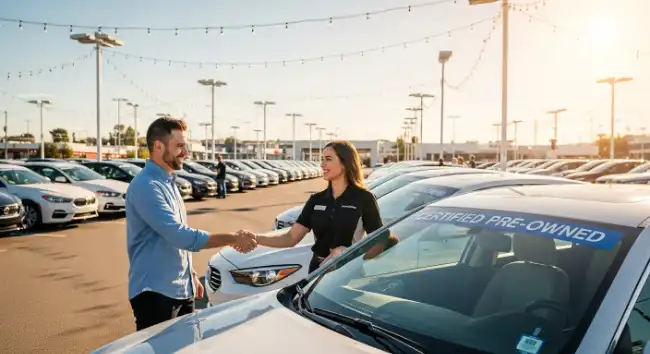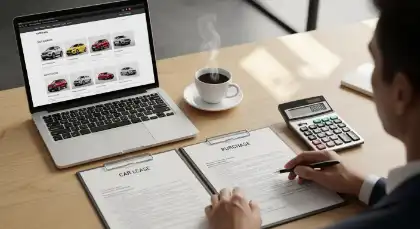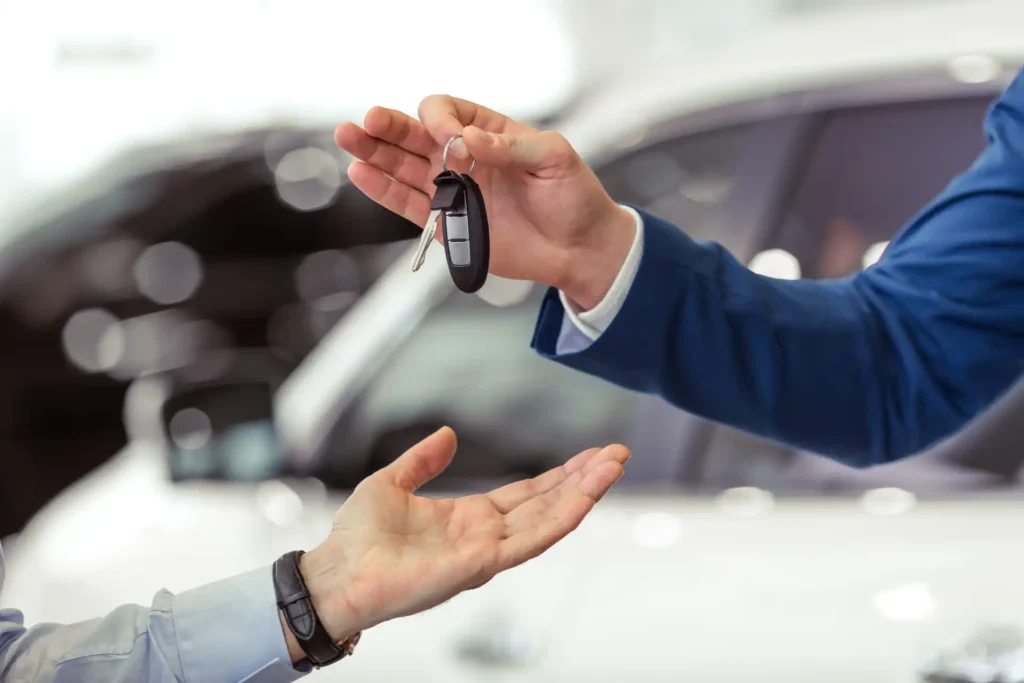Understanding the differences between leasing and buying a used car is crucial when considering how to obtain a vehicle. Each option has unique financial and practical implications that can significantly impact your lifestyle.
Leasing vs Buying a Used Car: This decision influences not only your monthly payments but also your long-term financial commitments and vehicle ownership experience.
Understanding these differences helps you make an informed choice that aligns with your financial situation, driving habits, and personal preferences. Choosing wisely between leasing and buying can lead to substantial savings and satisfaction in your vehicle use.
Buying a Used Car

Buying a used car means acquiring full ownership of a vehicle that has had one or more previous owners. This process typically involves searching for available vehicles through dealerships, private sellers, or certified pre-owned programs. Once you select a car, the purchase can be completed either by paying the entire price upfront (cash purchase) or by obtaining financing through an auto loan.
The Process of Buying
- Research and Selection: Identify makes, models, and years that fit your needs and budget.
- Vehicle History Check: Review maintenance records, accident history, and mileage.
- Inspection and Test Drive: Arrange for a thorough inspection and take the car for a test drive.
- Negotiation: Discuss price with the seller, factoring in market value and condition.
- Payment: Choose between paying cash or financing with a loan from a bank, credit union, or dealership.
- Title Transfer: Complete paperwork to transfer ownership and register the vehicle in your name.
Benefits of Ownership and Building Equity
Owning a used car provides full control over the vehicle:
- Unlimited Use: No restrictions on mileage or how you drive.
- Customization: Freedom to modify or personalize as you wish.
- Equity Building: As payments are made (if financed), you build equity; once paid off, you own the car outright.
- Asset Value: The vehicle becomes an asset you can keep, sell, or trade at any time.
With each payment toward your auto loan principal, your share of ownership increases—unlike leasing, where payments do not build any equity.
Financial Implications
- Upfront Costs: Typically higher than leasing; expect to pay a larger down payment, taxes, registration fees, and possible dealer fees.
- Monthly Payments: Higher monthly payments if financed compared to leasing due to the goal of full ownership.
- Long-Term Savings: After paying off the loan, ongoing costs drop significantly since there are no monthly payments—just maintenance, insurance, and registration.
Choosing to buy allows you to invest in long-term value while avoiding limitations common with leases. You assume responsibility for upkeep as the car ages, but gain flexibility and financial benefits from true ownership.
Leasing a Used Car
Leasing a used car offers a different approach than buying. Instead of purchasing the vehicle outright, you enter into a long-term rental agreement with the dealership or leasing company. This arrangement typically lasts between two and four years, during which you pay to use the car rather than working toward ownership.
How Leasing Works:
- You select a used vehicle and agree on a set lease term and annual mileage limit.
- The leasing company retains ownership of the car while you make fixed monthly payments throughout the lease period.
- At the end of the lease, you return the vehicle or sometimes have an option to purchase it at a predetermined price.
Lower Monthly Payments and Initial Costs:
Leasing a used car often appeals if you’re seeking lower up-front expenses and manageable ongoing costs.
- Monthly Payments: Lease payments are generally lower than loan payments for buying the same used car. This is because you’re only paying for the car’s depreciation over the lease term plus interest and fees—not its full value.
- Initial Costs: Upfront costs such as down payment, security deposit, and acquisition fee tend to be much less than what’s required to buy.
Mileage Limits and Penalties:
Leases come with specific usage restrictions:
- Mileage Limits: Most leases impose annual mileage caps—commonly between 10,000 and 15,000 miles per year.
- Penalties for Exceeding Limits: Going over these limits can result in steep per-mile charges at lease-end. For drivers with long commutes or frequent road trips, this can quickly add up.
- Modifications are usually prohibited, so customization options are limited.
Leasing a used car provides financial flexibility but comes with clear usage conditions.
Choosing this route suits those who want reliable transportation without committing to long-term ownership or high upfront investment. The structure is ideal if your driving habits fit within standard mileage limits and you value having access to newer models more frequently. However, it’s crucial to be aware of common pitfalls in car leasing.
Key Differences and Advantages Between Leasing and Buying
Ownership Status
When you buy a used car, you gain full ownership of the vehicle. This means you have the freedom to keep, sell, or trade it without restrictions once the loan is paid off. In contrast, leasing a used car does not grant you ownership. Instead, you’re essentially renting the vehicle for a set period, typically 2-4 years, after which you must return it or opt to purchase it at a predetermined price.
Monthly Payments and Cost Structures
Buying a used car generally involves higher monthly payments compared to leasing. These payments contribute towards owning the vehicle, eventually leading to no payments once the loan is paid off. On the other hand, leasing usually features lower monthly payments since you’re only paying for the car’s depreciation and rental charges over the lease term.
Impact on Equity
One of the significant advantages of buying is that it allows you to build equity in the car over time. As you make payments, your ownership stake increases until you own the vehicle outright. Leasing, however, does not build any equity. Your payments cover the cost of using the vehicle for a specific period without contributing towards ownership.
Term Length
The typical loan term for buying a used car ranges from 3-7 years. This longer term can be advantageous if you plan to keep the vehicle for an extended period. Leasing agreements, by comparison, are shorter, usually lasting between 2-4 years. This shorter term provides flexibility if you prefer driving newer vehicles more frequently.
Usage Flexibility
With buying, there are no restrictions on how much you drive or how you modify your vehicle. You have complete control over its usage and any modifications you wish to make. However, leasing comes with mileage limits—usually between 10,000-15,000 miles per year—and penalties for exceeding these limits. Additionally, leases often restrict modifications to ensure the vehicle can be returned in its original condition.
Financial Implications
The financial impact of buying versus leasing varies based on individual circumstances:
- Upfront Costs: Buying typically requires a larger down payment than leasing.
- Long-term Savings: Once you’ve paid off your loan when buying, you’ll have no further monthly payments and potentially benefit from long-term savings.
- Ongoing Payments: Leasing involves continuous monthly payments without ever leading to ownership, which can add up over multiple lease terms.
Understanding these differences helps in making an informed decision tailored to your financial situation and lifestyle preferences.
Factors Influencing the Decision to Lease or Buy a Used Car
1. Individual Financial Situations

Understanding your financial situation is critical when deciding between leasing and buying a used car. Leasing often requires lower monthly payments and smaller initial out-of-pocket expenses, making it an attractive option if you have limited cash flow or prefer to keep more liquidity. However, buying a car means higher upfront costs and larger monthly payments, but it allows you to build equity over time. If long-term ownership and eventual cost savings are important to you, purchasing might be the better choice.
2. Driving Habits and Annual Mileage Limits
Your driving habits play a crucial role in this decision. Leases typically come with mileage restrictions ranging from 10,000 to 15,000 miles per year. Exceeding these limits can result in significant penalties at the end of the lease term. If you have a long daily commute or enjoy road trips, buying a car could be more practical since there are no mileage caps. Conversely, if your annual mileage is low, leasing may provide financial benefits without risking additional fees.
3. Preferences for Vehicle Ownership vs. Flexibility in Usage
Consider your preference for vehicle ownership versus flexibility. Owning a car gives you complete control over its use and modifications. You can personalize it as much as you like without worrying about lease agreements. Additionally, once the loan is paid off, you can enjoy years of payment-free driving. On the other hand, leasing offers the flexibility of driving newer models every few years with lower repair costs since leased vehicles are usually under warranty. This can be appealing if you like having access to the latest features and technology without long-term commitments.
4. Understanding Auto Insurance Implications
Another critical aspect to consider is the auto insurance implications of leasing versus buying. When you buy a car, you might have more freedom in choosing your insurance coverage as opposed to leasing, where certain requirements might be imposed by the leasing company.
5. Frequency of Vehicle Change
Lastly, think about how often you plan on changing your vehicle. If you’re someone who prefers to switch cars frequently, leasing might be more suitable as it allows for easier transitions into newer models every few years without the hassle of selling an old one.
Understanding these factors will help tailor your decision to your specific needs and lifestyle preferences.
Leasing appeals if predictable costs and driving new models matter most; buying rewards those looking for control, unlimited use, and value over time.
Each approach fits different priorities—leasing emphasizes lower initial costs and convenience, while buying focuses on permanent ownership and financial payoff.
Making an Informed Decision: Final Thoughts on Leasing vs Buying a Used Car
Understanding the differences between leasing and buying a used car is essential for making the best decision for your needs. Personal preferences, financial circumstances, and driving habits play crucial roles in determining the most suitable option.
Key considerations include:
- Personal Preferences: Decide whether you value ownership and long-term cost savings or prefer the flexibility of having newer vehicles more frequently.
- Financial Circumstances: Evaluate your budget for upfront costs and monthly payments. Consider long-term financial commitments versus short-term affordability.
- Driving Habits: Assess your annual mileage and usage patterns. Leasing may not be ideal if you frequently exceed mileage limits.
By taking these factors into account, you can make an informed decision that aligns with your lifestyle and financial goals.

